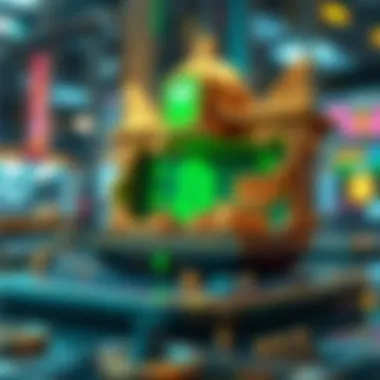Advanced Strategies for Profit in NFTs


Intro
In recent years, non-fungible tokens (NFTs) have emerged as a transformative force within the digital economy. They offer a new way to own and trade digital assets, bridging the gap between virtual and real-world value. While this space can often seem volatile, with prices that can swing like a pendulum, the potential for profit generation is substantial. Investors and creators alike are tuning into the myriad ways to monetize NFTs. This article presents a nuanced discussion that dives into advanced strategies for making the most out of these digital tokens.
Understanding the key trends in cryptocurrency and investment strategies forms the backbone of navigating this landscape. By discerning the underlying market dynamics and employing effective risk management techniques, anyone from a novice to a seasoned pro can enhance their approaches. With the right information at your fingertips, the path toward financial gain in the NFT realm becomes clearer and more achievable.
Let’s embark on this journey, uncovering vital insights that can forge pathways to success in the burgeoning world of NFTs.
Understanding NFTs
Grasping the essence of non-fungible tokens (NFTs) is crucial for anyone looking to profit from this burgeoning digital landscape. NFTs represent a paradigm shift in assets, offering unique ways to own, sell, and trade items ranging from art to real estate. Their importance cannot be overstated, as they’re not just a trend but a new way to assign value and provenance in the digital space.
Several factors highlight the relevance of understanding NFTs. First, as technology continually evolves, the demand for knowledge in digital asset management increases. Knowing how NFTs work is fundamental for making informed investment decisions and effectively navigating marketplaces. Second, each NFT holds distinct properties, which can significantly impact its value on the market. This uniqueness is central to the profit strategies discussed later in this article. To optimize your investments and minimize risks, a deep dive into NFTs is not just advantageous—it's necessary.
Definition of NFTs


Non-fungible tokens, or NFTs, are digital assets that represent ownership or proof of authenticity of a unique item, using blockchain technology. Unlike cryptocurrencies such as Bitcoin or Ethereum which are interchangeable, NFTs are one-of-a-kind. Each NFT has a specific value and is verifiable through the blockchain, which ensures that its authenticity and ownership can be efficiently monitored.
These tokens can represent anything digital, from artwork and music to game items and domain names. Essentially, they confer ownership over a digital item just like a physical collector's item would. With the advent of NFTs, the digital art world, for instance, has transformed, allowing artists to monetize their creations in ways that were previously impossible.
Key Properties
Understanding the core properties of NFTs can enlighten investors on the nuances that create monetary opportunities. Here are several key aspects to consider:
- Indivisibility: You cannot split an NFT into smaller units as you can with cryptocurrencies. This property enhances the uniqueness and potentially increases its value.
- Tokenization: NFTs encapsulate ownership in a way that is transparent and immutable via blockchain. Each transaction is recorded, creating an unchangeable history.
- Interoperability: Most NFTs are built on Ethereum, allowing them to function seamlessly across various applications and marketplaces that support this network.
- Scarcity: The creator can limit the number of NFTs produced for an item, which can heighten its allure and collectible potential, similar to limited edition prints.
Comparison to Traditional Assets
When contrasting NFTs with traditional assets, the differences become immediately apparent. While physical assets are often bound by location and ownership complexities, NFTs transcend these limitations. Here’s how they stack up:
- Ownership Clarity: With traditional assets such as real estate or fine art, proving ownership often requires extensive paperwork. NFTs simplify this process through blockchain, offering clear, accessible ownership records.
- Liquidity: Selling and trading physical assets can be cumbersome. NFTs can be bought, sold, or traded instantaneously on various platforms, enhancing their liquidity in the market.
- Global Reach: Traditional assets are frequently confined to local markets. NFTs operate globally, allowing artists and investors to connect with a worldwide audience without geographical constraints.


"As the digital world expands, understanding NFTs is not merely beneficial; it’s essential for anyone involved in investment strategies today."
By understanding what NFTs are, their key properties, and how they compare to traditional assets, one can better navigate the marketplace to derive maximum profit potential from these intriguing digital innovations.
Creating Your Own NFTs
Creating your own NFTs forms a crucial foundation in the world of digital assets, transforming unique digital creations into tradable commodities on the blockchain. This process offers not only artistic expression but also potential financial reward. By understanding how to create NFTs, you’re stepping into a sphere where your creativity can be monetized, influencing both the cultural and economic landscapes of the digital realm.
Choosing a Niche
When venturing into the NFT space, selecting the right niche is paramount. Your niche should not only align with your interests and expertise but should also resonate with an audience. This might be digital art, music, virtual real estate, or even collectibles. Find what captivates you; passion will carry you a long way.
There are several valuable considerations:
- Market Research: Explore what types of NFTs are trending and why. Dive into marketplaces like OpenSea or Rarible to understand what attracts buyers.
- Community: Engage with existing communities, whether on platforms like Discord or Twitter. Building relationships can offer insights into the preferences and needs of potential buyers.
- Unique Value Proposition: Think about how your NFT can stand out. What can you offer that’s different from the rest? Perhaps it’s an incorporation of augmented reality or interactive elements.


Choosing your niche thoughtfully ensures you’re not just swimming in the deep end of the pool, but rather in the right water where you can thrive.
Art and Digital Content Creation
Creating the actual content for your NFT is where the magic begins. This involves more than just uploading images or tracks; it’s about crafting something that speaks to your target audience. Whether you’re an artist, musician, or content creator, your goal should be to produce items that draw the eye and provoke thought.
- Quality Matters: Ensure your work has high production values. Low-quality images or poorly mixed audio can deter buyers before they even consider purchasing.
- Innovative Techniques: Utilize new digital tools and techniques to create above-average content. Consider tools like Adobe Creative Cloud for design or GarageBand for sound mixing.
- Copyright Awareness: Be mindful of copyright issues. Ensure that any elements you integrate don’t infringe on someone else's intellectual property. Ownership is crucial in this field, and keeping your work original is a must.
This is an art form where the old adage "you get what you pay for" truly applies. The more effort and creativity that goes in, the higher the potential reward.
Technical Aspects of Minting
Minting NFTs involves converting your digital creation into a secure digital token on the blockchain. This phase requires a certain degree of technical knowledge, yet the process has become increasingly user-friendly as platforms evolve.
- Choose a Blockchain: Choose a blockchain that supports NFTs. Ethereum is widely recognized, but options like Binance Smart Chain and Polygon are also gaining traction due to lower fees and faster transactions.
- Wallet Setup: You usually need a digital wallet compatible with your chosen blockchain. Popular options are MetaMask or Trust Wallet.
- Minting Process: Most NFT platforms guide you through minting. Generally, it requires uploading your file, entering specific details about your NFT, and deciding on royalties for future sales.
plaintext Example of minting steps:
- Connect Wallet
- Upload File
- Set Properties
- Confirm and Mint



